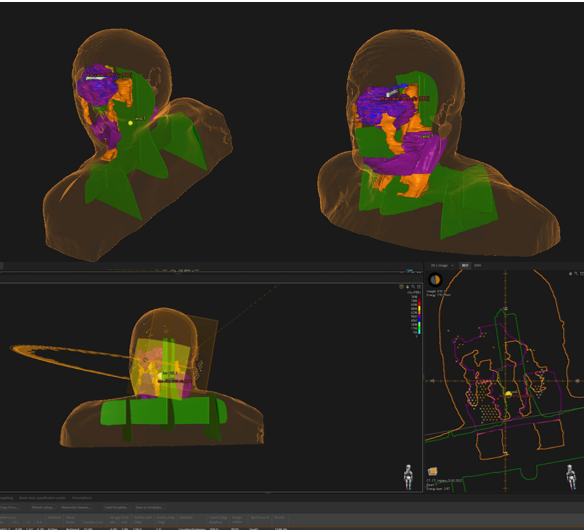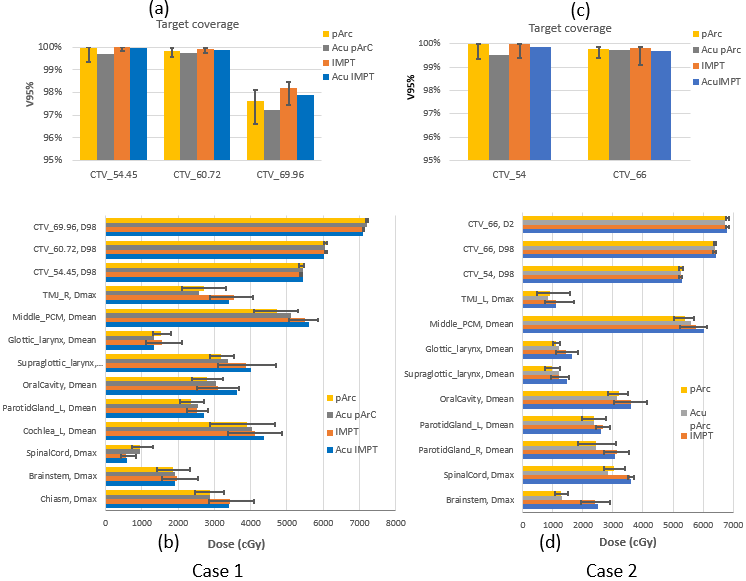Assesment of scenarios based and intrafractional robustness of dynamic proton arc plans
JUAN MARIA PEREZ MORENO,
Spain
PO-1986
Abstract
Assesment of scenarios based and intrafractional robustness of dynamic proton arc plans
Authors: JUAN MARIA PEREZ MORENO1, Erik Engwall2, Viktor Wase2, Juan Castro Novais1, Juan Antonio Vera Sánchez1, Fernando Cerrón Campoo1, Isabel Lorenzo Villanueva1, Elisabet Canals de las Casas1, Otte Martin2, Johan Sundström2, Marta Montero Feijoo1, Morena Sallabanda Hajro1, Ana de Pablo González1, Raúl Matute Martín1, Raymond Miralbell1, Alejandro Mazal1
1Quirónsalud Protontherapy Center, Radiation Oncology, Pozuelo de Alarcón (Madrid), Spain; 2RaySearch Laboratories, Research and Development, Stockholm, Sweden
Show Affiliations
Hide Affiliations
Purpose or Objective
To perform initial evaluation of dynamic proton arc therapy plan robustness through a set of perturbed scenarios and intra-fractional robustness.
Material and Methods
Two head and neck cases treated with IMPT were selected for a retrospective evaluation with a novel proton therapy delivery technique based on dynamic arcs (pArc) (1). The actual delivered IMPT were calculated in Raystation 10B for a Proteus One using a total of 7 proton beams irradiating different target volumes according to patient geometry. pArc plans were designed in Raystation 12B using a 360º rotation and 2 revolutions arc. In the Proteus One compact gantry the full rotation is achieved by combining two 180º arcs and two couch positions. A small couch kick was used to reduce uncertainties in shoulders positioning. Blocking contours were used to control spot selection to avoid directions and energies evaluated as non-robust under a classical proton treatment planning approach (Figure1). Both plans were robustly optimized using 3.5% range uncertainty and 2mm and 3mm setup uncertainty in head and neck areas respectively.
Plan robustness were assessed with two methods. First, pre-treatment evaluation based on calculation of 28 perturbed scenarios of nominal plan, using a setup and range uncertainties of 2mm and 3%, respectively. Secondly, by recomputing the nominal plan on weekly CT scans acquired during the treatment course. The total delivered dose is estimated by deforming and accumulating the weekly evaluation doses to the planning CT.

Results
The plan generation workflow is similar for IMPT and pArc with two major differences : weights required by pArc to achieve good targets coverage are significantly larger than for IMPT and pArc requires additional initial time for energies and spot selection algorithm. However, in the cases under study, the time for energy and spot selection is still below 2 minutes.
Figure 2a-d show clinical goals evaluated for the two cases for pArc and IMPT. Error bars indicate the range of variation of every clinical goal evaluated over the set of perturbed scenarios on the planning CT. IMPT and pArc show similar range of variation. Clinical goals evaluated on the accumulated dose from the weekly CTs show that the deviations from the nominal plan are similar for both treatment techniques.
In general, for equivalent target coverage, doses at OARs are lower in pArc plans.

Conclusion
Dynamic arc proton therapy is a feasible technique from a treatment planning perspective, with the potential advantage of improvement in OAR sparing and delivery efficiency for complex cases that could require multiple IMPT beams. Using avoidance ROIs can help to pArc algorithm to achieve plans as robust as IMPT. Analysis of more cases are needed to confirm these findings. The inclusion of LET optimization could help to further exploit potential radiobiological advantages of this delivery technique (2).
Refs:
1. doi.org
2. doi.org